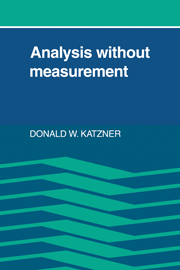Book contents
- Frontmatter
- Contents
- Preface
- Dedication
- 1 Introduction
- 2 Notes on measurement
- Part I Theoretical methods
- 3 Basic concepts
- 4 Algebraic structure
- 5 Analysis of specific systems
- 6 General systems
- 7 Some epistemological considerations
- Part II Applications to theoretical problems
- Part III Empirical verification
- Index
7 - Some epistemological considerations
Published online by Cambridge University Press: 04 August 2010
- Frontmatter
- Contents
- Preface
- Dedication
- 1 Introduction
- 2 Notes on measurement
- Part I Theoretical methods
- 3 Basic concepts
- 4 Algebraic structure
- 5 Analysis of specific systems
- 6 General systems
- 7 Some epistemological considerations
- Part II Applications to theoretical problems
- Part III Empirical verification
- Index
Summary
The aim of Chapters 3 to 6 has been to develop a guiding methodology for analysis when measurement of at least one of the factors under investigation is not now and may never be possible. Variables and relations between them were defined and tools for manipulation were proposed. This led to the emergence of model-building techniques that are analogous to those often employed in the examination of scalable phenomena. A logical basis for the conduct of analysis without measurement has thereby been established.
Loose ends, nevertheless, remain. The translation of nonquantifiable concepts into nonquantifiable variables; the meaning of infinity in the absence of numerical calibration; and the representation of time, change, and evolution in such a context all require further explanation. In particular, it is necessary to explore the role these elements play in the conduct of inquiry and the resulting contribution to the understanding of reality that emerges from them. Attention is now turned to these kinds of issues.
The intent of the following discussion is clearly different from that of Section 1.3. The purpose of the latter was to illustrate the notion that what is most often referred to as “scientific analysis” does not – insofar as its philosophical underpinnings are concerned – depend on measurement. Thus organizational constructs (e.g., assumptions, laws, theories), guidelines for argument, and methods of definition, to name a few, retain their meaning and force in nonquantifiable circumstances. But the way in which various facets of reality are represented in analytical constructs, and the implications for the knowledge so obtained, have until now been ignored.
- Type
- Chapter
- Information
- Analysis Without Measurement , pp. 137 - 156Publisher: Cambridge University PressPrint publication year: 1983



